This premium content is exclusive to edie Members.
To find out more about edie Membership, please click below.
If you are an existing member, login here
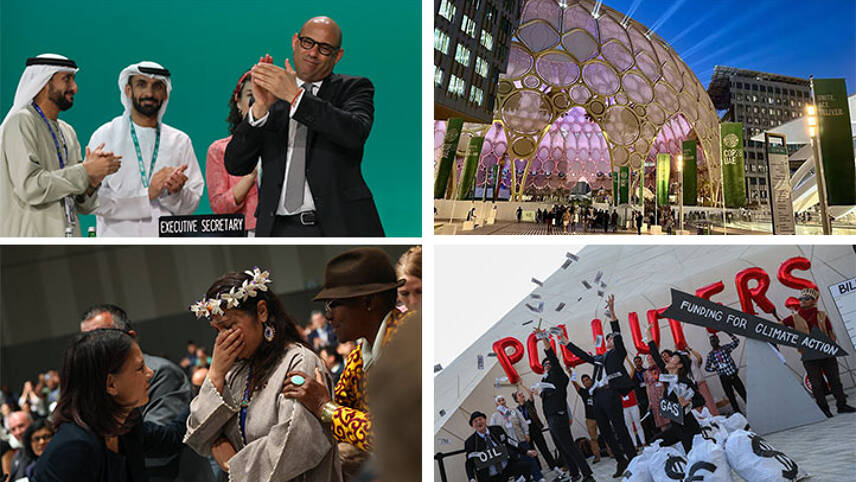
Image top right: Luke Nicholls for edie. Other images: UNFCCC Flickr / Kiara Worth
COP28 came to a close shortly before midday on Wednesday, a full day after the UAE Presidency had hoped for a conclusion. Negotiators worked through the night to broker the final agreement, which has prompted mixed reactions.
In all the hubbub around the final text, the so-called UAE Consensus, it can be easy to lose sight of the other major happenings over the past two weeks.
Here, edie recaps on ten of the biggest headline takeaways from COP28.
The UAE Consensus was agreed, without small island states in the room

Pictured: COP28 President Dr Sultan Al Jaber and Director-General Majid Al Suwaidi at the closing plenary. Image: UNFCCC
The COP28 Presidency closed off COP28 with an agreement that it has badged as unanimous. No last-minute interjections were made, as were seen at COP26. But the Alliance of Small Island States has told media that its representatives were not given the chance to enter the plenary room and sit down, to have any chance to object.
Ultimately, the text discusses a “transition away” from fossil fuels that nonetheless has loopholes for carbon capture, gas as a transition fuel and fossil subsidies.
The big row over the final texts, throughout the two weeks, was undeniably around fossil fuels and whether they should be phased out or down. Nations including Saudi Arabia and the Africa Group blocked the inclusion of a phase-out, instead calling for a phase-down and an ‘abatement’ loophole for carbon capture. The US was also a proponent of abatement, as is the UK.
Ultimately, the text mentions neither phasing out nor down. Nations should “reduce both consumption and production of fossil fuels, in a just, orderly and equitable manner so as to achieve net-zero by, before, or around 2050 in keeping with the science”.
Action should be accelerated this decade. But the text goes on to list some caveats to the general energy transition message. Nations can continue providing fossil fuel subsidies if they are “efficient”. Carbon capture is listed as a potential alternative to transitioning the generation mix towards nuclear and renewables. There is wording that emphasises gas as a “transition fuel”.
The text also lacks a specific, time-bound plan to improve adaptation and any new finance for this workstream. Other notable omissions include decisions on most key carbon markets mechanisms and on a post-2025 international climate finance goal, building from a $100bn floor.
You can access edie’s full summary of the text here.
You can read a round-up of initial reactions to the text here.
Negotiators worked tirelessly to update an ‘unacceptable’ draft
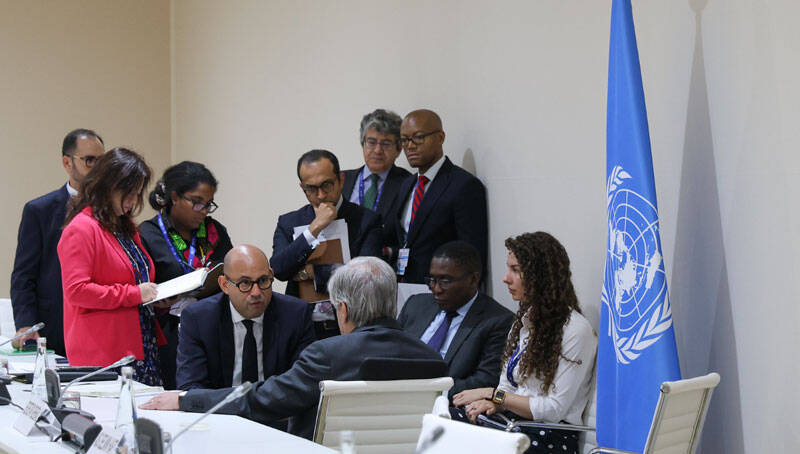
Pictured: UNFCCC staff digest draft texts behind the scenes in Dubai. Image: UNFCCC Flickr, Kiara Worth
Before the UAE Consensus was finalised, the previous draft Global Stocktake was almost unanimously rejected. Released on Monday (11 November), the draft had significant gaps and options for no text for topics ranging from adaptation plans to mitigation finance.
It also made no mention of a fossil fuel transition – only to reducing consumption and production by 2050, with no emphasis on this decade. Furthermore, it listed solutions such as renewables and energy efficiency as a “menu” of potential options.
Key changes were made in these fields before the final text. This final Consensus text also firmed up official delays on discussions on carbon markets, a post-2025 finance goal and an adaptation agenda. But, on the plus side, language was strengthened to recognise the roles and rights of Indigenous communities in the energy and agriculture transitions – and as nature conservation and restoration efforts scale.
Negotiators worked from when the draft came on Monday afternoon, to 3am on Wednesday to make the updates. The COP28 Presidency then worked them into a final presentation for 6am on Wednesday.
The Loss & Damage Fund was operationalised and Santiago Network set up for launch

US Climate Envoy John Kerry (left) was slammed for only contributing $17.5m. Image: UNFCCC Flickr/ Kiara Worth
It bears looking back to the changing mood and tone of the COP from start to finish. As the summit began, the organisers confirmed that the world’s first dedicated Loss and Damage fund was officially set up.
COP27 saw wealthy nations U-turn on their historic opposition to the creation of a dedicated global funding pot for loss and damage. But the process of operationalising the fund was hard-fought. Extra emergency meetings took place in Abu Dhabi in November after negotiators were unable to agree on fund specifics to time.
These were successful. As COP28 began, initial commitments to the fund were made by the UAE ($100m), Germany ($100m), the UK (£40m), the US ($17m) and Japan ($10m). The US in particular was called upon to add more, but is unlikely to do so without a guarantee that the fund won’t pay out to China.
As COP28 closed, the fund stood near the $800m mark. Climate-affected nations now want to see the millions turned into trillions.
By some estimates, climate-related losses and damages averaged £115bn annually between 2000 and 2019. This figure is a conservative estimate as it only accounted for standalone extreme weather events, not slower trends such as soil degradation or coastal erosion.
The Network will be jointly hosted by two UN bodies, as agreed earlier this month. It will work to streamline the pathways through which climate-affected nations and regions are able to access technical assistance to prevent losses and damages, and to rectify them when they do occur.
The Global Decarbonisation Accelerator gained support from 130+ nations
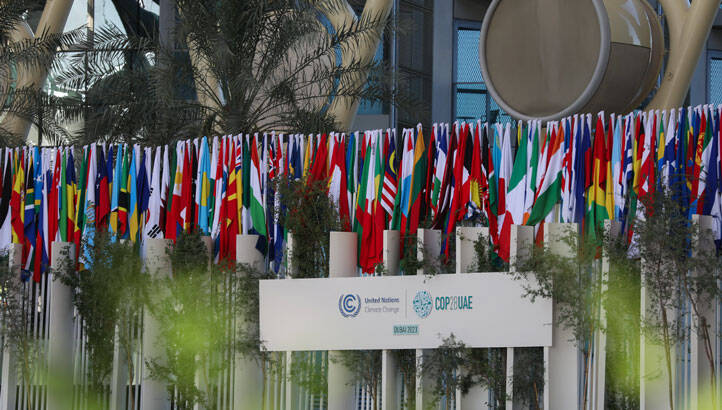
Image: UNFCC Flickr / Kiara Worth
On 2 December, more than 100 nations signed on to a new ‘Global Decarbonisation Accelerator’. Sitting separately from the main agreement, this initiative includes pledges to triple global renewable capacity and double annual energy efficiency improvement rates by 2030.
This Accelerator was developed by the COP28 UAE Presidency and the International Energy Agency (IEA). The IEA has stated that these two facets are important to keep 1.5C in reach, but must be coupled with concerted efforts to end fossil fuel projects with long lead times in the immediate future.
Methane is also on the menu. The Accelerator stipulates that nations should make significant cuts to this potent gas this decade, ideally beyond the 30% reduction that 150 nations already support.
A total of 130+ nations have now supported the Accelerator, but notable absences including India and China remain.
Another dampener is the fact that the Accelerator was paired with a new voluntary commitment for oil and gas firms to tackle their operational emissions, which cover just 5% of their climate footprint. Read edie’s full story here.
The Declaration on Relief, Recovery and Peace fell somewhat flat

Image: UNFCCC Flickr / Mahmoud Khaled
The first thematic day in the Presidency’s agenda, 3 December, was dedicated to recovery, relief and peace. It was always going to be necessary yet challenging to set aside dedicated time on these topics, which underpin the entire UN Sustainable Development Goals (SDGs) agenda, with live conflicts including Russia-Ukraine and Israel-Hamas.
The UAE, for its part, permitted the Israeli delegation to attend, prompting Iran to walk out in week one. It also permitted Putin to visit Abu Dhabi while COP28 was in session. Peaceful demonstrations have been a regular feature in the Blue and Green Zones, even though participants on ‘UN soil’ in Blue are meant to refrain from political flags, slogans or messages. Some pavilions were handing out subtle ‘solidarity with Palestine’ lanyards throughout the summit, too.
It bears noting that more than 190 nations are involved in the UN climate diplomacy process, meaning that the majority are not signed up. It is also worth flagging that the Declaration includes noting on reducing emissions from militaries, which generate 5.5% of annual global emissions.
Food came under the spotlight
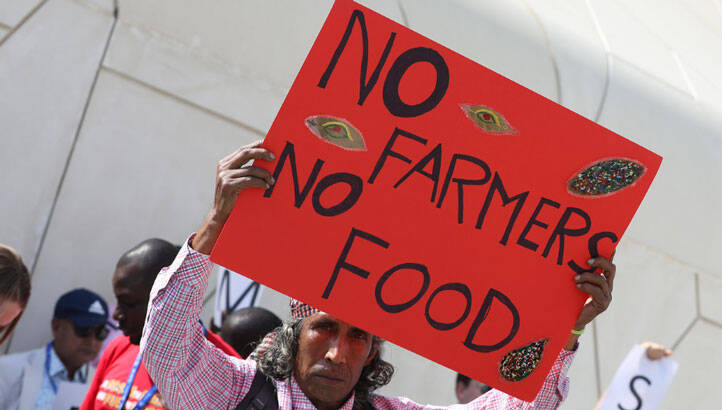
Iamge: UNFCC Flickr / Kiara Worth
The thematic agenda on 10 December was dedicated to agriculture, land-use and water. Coinciding with this, the UN’s Food and Agriculture Organization (FAO) unveiled a sweeping three-year programme to radically transform land use and food systems in a bid to eliminate hunger globally while also aligning agriculture with the 1.5C pathway of the Paris Agreement. It is essentially a food systems version of the IEA’s 2050 net-zero pathway for energy systems. You can read edie’s full story here.
The COP28 Presidency, meanwhile, convened 130+ nations behind a new ‘Emirates Declaration’ to urgently reduce the environmental impact of food systems and improve their climate resilience. This declaration covers adaptation, water management, conservation, food waste, dietary changes and the nutrition challenge. Read edie’s full story here.
The final text notes the link between food systems and adaptation but makes no new commitments on cutting emissions from food systems as a means of mitigation.
Lobbyists’ presence was assessed in new levels of detail
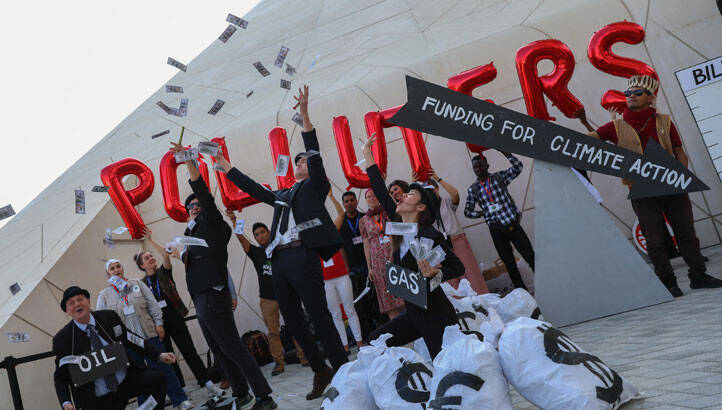
Image: UNFCCC / Kiara Worth
Anyone visiting the Energy pavilion in the Blue Zone will have been greeted by the sight of the OPEC stall. The alliance of petrostates has long attended COPs but had a prominent position this year.
Campaign group Kick Polluters Out (KPO) trawled through the list of 100,000+ registered COP28 attendees to determine how many were fossil fuel lobbyists. It applies this label to decision-makers at state-owned and private energy companies, plus delegations of petrostates with major expansion plans.
KPO estimates that around 2.5% of attendees fit its definition of a fossil fuel lobbyist. For context, this is five times the number of scientists on the ground, and seven times the number of Indigenous representatives. KPO has tracked a fourfold increase in fossil fuel lobbyists on the numbers present last year at COP27 in Egypt.
Building on this, InfluenceMap assessed whether corporates across the array of economic sectors were likely to use COP28 for progressive lobbying or to block progress.
Fewer than one in ten of the corporations present at COP28 are deemed by InfluenceMap as truly aligning their climate policy engagement with the changes that scientists believe are necessary to keep the Paris Agreement’s 1.5C pathway in reach. InfluenceMap tracked large parties in attendance from Russian oil and gas major Gazprom, plus US-headquartered fossil fuel majors ExxonMobil and Chevron.
Macron and Bloomberg unveiled a global corporate emissions database

Image: UNFCCC Flickr / Christopher Pike
While world leaders were speaking on 1-2 December, COP28 also convened a new Business and Philanthropy Climate Forum in partnership with Bloomberg. A total of $5bn of funding was pledged during the Forum.
The Net-Zero Data Public Utility (NZDPU) will provide information on corporate Scope 1, 2 and 3 emissions, reduction targets and any transition-related data. It will be populated with the data from companies that disclose through CDP.
It is now live in beta form and a public consultation is open through March 1, 2024 to give stakeholders the chance to feedback on the development of the platform.
“The most valuable currency in financial markets is reliable data,” said Michael R. Bloomberg. “This new data portal will allow investors and regulators to see which companies are making progress on their commitments, while also empowering the public to hold companies accountable for backing up words with action.
Click here to view all of edie’s COP28 content


Please login or Register to leave a comment.